Related Research Articles

The Balfour Declaration was a public statement issued by the British Government in 1917 during the First World War announcing its support for the establishment of a "national home for the Jewish people" in Palestine, then an Ottoman region with a small minority Jewish population. The declaration was contained in a letter dated 2 November 1917 from the United Kingdom's Foreign Secretary Arthur Balfour to Lord Rothschild, a leader of the British Jewish community, for transmission to the Zionist Federation of Great Britain and Ireland. The text of the declaration was published in the press on 9 November 1917.

Zionist political violence refers to acts of violence or terrorism committed by Zionists in support of establishing and maintaining a Jewish state in Palestine. These actions have been carried out by individuals, paramilitary groups, and the Israeli government, from the early 20th century to the present day, as part of the ongoing Israeli-Palestinian conflict.
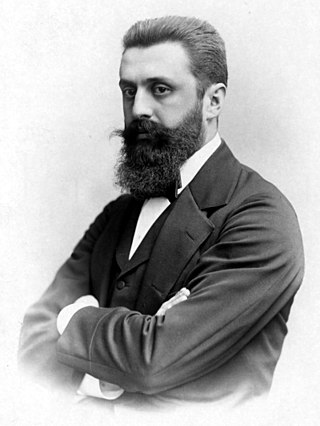
Zionism is an ethno-cultural nationalist movement that emerged in Europe in the late 19th century and aimed for the establishment of a Jewish state through the colonization of a land outside of Europe. It eventually focused on the establishment of a Jewish homeland in Palestine, a region corresponding to the Land of Israel in Judaism, and of central importance in Jewish history. Zionists wanted to create a Jewish state in Palestine with as much land, as many Jews, and as few Palestinian Arabs as possible. Following the establishment of the State of Israel in 1948, Zionism became the ideology supporting the protection and development of Israel as a Jewish state and has been described as Israel's national or state ideology.
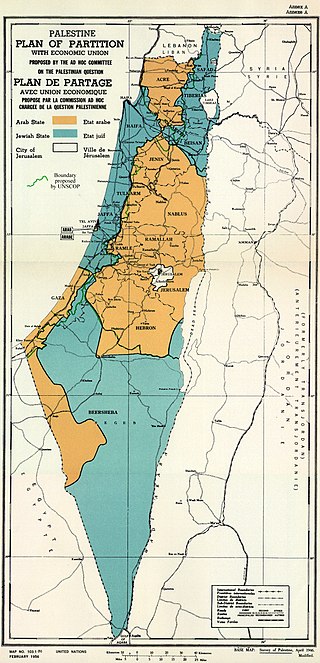
The United Nations Partition Plan for Palestine was a proposal by the United Nations, which recommended a partition of Mandatory Palestine at the end of the British Mandate. On 29 November 1947, the UN General Assembly adopted the Plan as Resolution 181 (II). The resolution recommended the creation of independent Arab and Jewish States linked economically and a Special International Regime for the city of Jerusalem and its surroundings.
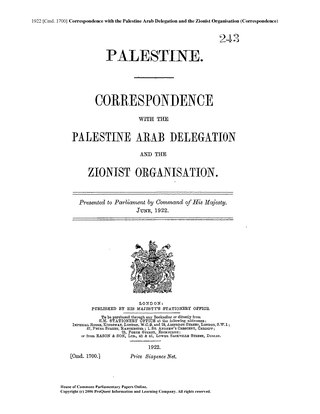
The Churchill White Paper of 3 June 1922 was drafted at the request of Winston Churchill, then Secretary of State for the Colonies, partly in response to the 1921 Jaffa Riots. The official name of the document was Palestine: Correspondence with the Palestine Arab Delegation and the Zionist Organisation. The white paper was made up of nine documents and "Churchill's memorandum" was an enclosure to document number 5. While maintaining Britain's commitment to the Balfour Declaration and its promise of a Jewish national home in Mandatory Palestine, the paper emphasized that the establishment of a national home would not impose a Jewish nationality on the Arab inhabitants of Palestine. To reduce tensions between the Arabs and Jews in Palestine the paper called for a limitation of Jewish immigration to the economic capacity of the country to absorb new arrivals. This limitation was considered a great setback to many in the Zionist movement, though it acknowledged that the Jews should be able to increase their numbers through immigration rather than sufferance.

Yishuv, HaYishuv HaIvri, or HaYishuv HaYehudi Be'Eretz Yisra'el denotes the body of Jewish residents in Palestine prior to the establishment of the State of Israel in 1948. The term came into use in the 1880s, when there were about 25,000 Jews living in that region, and continued to be used until 1948, by which time there were some 630,000 Jews there. The term is still in use to denote the pre-1948 Jewish residents in Palestine, corresponding to the southern part of Ottoman Syria until 1918, OETA South in 1917–1920, and Mandatory Palestine in 1920–1948.
The Biltmore Conference, also known by its resolution as the Biltmore Program, was a fundamental departure from traditional Zionist policy by its demand "that Palestine be established as a Jewish Commonwealth." The meeting was held in New York City, at the prestigious Biltmore Hotel, from May 9 to May 11, 1942, with 600 delegates and Zionist leaders from 18 countries attending.

The Peel Commission, formally known as the Palestine Royal Commission, was a British Royal Commission of Inquiry, headed by Lord Peel, appointed in 1936 to investigate the causes of conflict in Mandatory Palestine, which was administered by the United Kingdom, following a six-month-long Arab general strike.

The White Paper of 1939 was a policy paper issued by the British government, led by Neville Chamberlain, in response to the 1936–1939 Arab revolt in Palestine. After its formal approval in the House of Commons on 23 May 1939, it acted as the governing policy for Mandatory Palestine from 1939 to the 1948 British departure. After the war, the Mandate was referred to the United Nations.
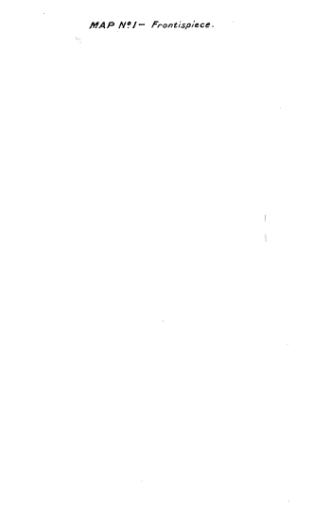
The Shaw Report, officially the Report of the Commission on the Palestine Disturbances of August 1929, commonly known as the Shaw Commission, was the result of a British commission of inquiry, led by Sir Walter Shaw, established to investigate the violent rioting in Palestine in late August 1929. The commission's report was issued in March 1930 and led to the establishment of the Hope Simpson Enquiry in May 1930.
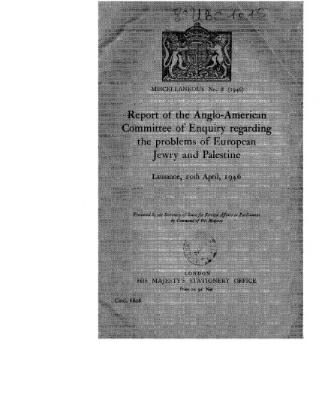
The Anglo-American Committee of Inquiry was a joint British and American committee assembled in Washington, D.C., on 4 January 1946. The committee was tasked to examine political, economic and social conditions in Mandatory Palestine and the well-being of the peoples now living there; to consult representatives of Arabs and Jews, and to make other recommendations 'as may be necessary' to for ad interim handling of these problems as well as for their permanent solution. The report, entitled "Report of the Anglo-American Committee of Enquiry Regarding the Problems of European Jewry and Palestine", was published in Lausanne on 20 April 1946.
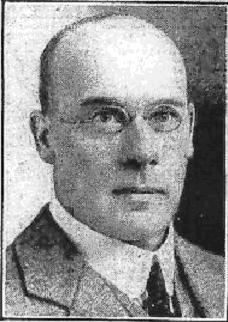
The Report on Immigration, Land Settlement and Development, commonly referred to as the Hope Simpson Enquiry or the Hope Simpson Report, was a British Commission managed by Sir John Hope Simpson, established during August 1929 to address Immigration, Land Settlement and Development issues in British Mandate of Palestine, as recommended by the Shaw Commission, after the widespread 1929 Palestine riots.

During the British rule in Mandatory Palestine, there was civil, political and armed struggle between Palestinian Arabs and the Jewish Yishuv, beginning from the violent spillover of the Franco-Syrian War in 1920 and until the onset of the 1948 Arab–Israeli War. The conflict shifted from sectarian clashes in the 1920s and early 1930s to an armed Arab Rebellion against British rule in 1936, armed Jewish Revolt primarily against the British in mid-1940s and finally open war in November 1947 between Arabs and Jews.

Events in the year 1930 in the British Mandate of Palestine.
Albert Montefiore Hyamson, was a British civil servant and historian who served as chief immigration officer in the British Mandate of Palestine from 1921 to 1934.

The London Conference of 1939, or St James's Palace Conference, which took place between 7 February – 17 March 1939, was called by the British Government to plan the future governance of Palestine and an end of the Mandate. It opened on 7 February 1939 in St James's Palace after which the Colonial Secretary, Malcolm MacDonald held a series of separate meetings with the Arab Higher Committee and Zionist delegation, because the Arab Higher Committee delegation refused to sit in the same room as the Zionist delegation. When MacDonald first announced the proposed conference he made clear that if no agreement was reached the government would impose a solution. The process came to an end after five and a half weeks with the British announcing proposals which were later published as the 1939 White Paper.

Mandatory Palestine was a geopolitical entity that existed between 1920 and 1948 in the region of Palestine under the terms of the League of Nations Mandate for Palestine.
This is a timeline of intercommunal conflict in Mandatory Palestine.

Palestine: A Policy is a history book by British civil servant and historian, Albert Montefiore Hyamson, which provides a history of the idea and practise of Zionism from the Eighteenth Century and the British Mandate for Palestine until 1942.
The MacDonald letter, also known in contemporary Arabic sources as the Black Letter, was a letter from British prime minister Ramsay MacDonald to Chaim Weizmann on 13 February 1931 regarding the passage of the Passfield white paper, which recommended restrictions on Jewish immigration to Palestine, as well as Jewish purchases of land in Palestine. Zionist organizations worldwide mounted a vigorous campaign against the document, which culminated in MacDonald's "clarification" of the White Paper, reaffirming British support for the continuation of Jewish immigration and land purchase in Palestine. It was considered a withdrawal of the Passfield white paper, despite the fact that Prime Minister stated in parliament on 11 February 1931 that he was "very unwilling to give the letter the same status as the dominating document" i.e. the Passfield white paper. The letter itself also claimed the importance of justice for "non-Jewish sections of the community".
References
- ↑ Shapira (2014), 86-7.
- ↑ Hyamson (1942), p. 146. Hyamson mentions that this Arab disappointment probably had something to do with the fact that following the white paper Jewish immigration continued at higher levels than they wanted, the purchase of land by Jews continued without restrictions, and the steps taken to protect Arab tenant farmers from being removed from their land was ineffective. p.145
- ↑ Shapira (2014), p. 87.